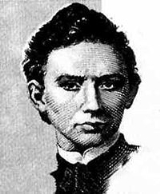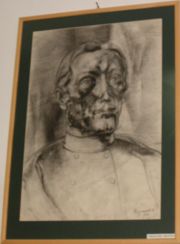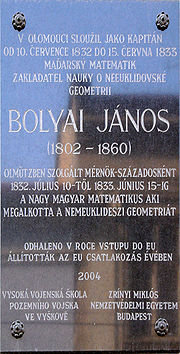
János Bolyai
Encyclopedia


Mathematician
A mathematician is a person whose primary area of study is the field of mathematics. Mathematicians are concerned with quantity, structure, space, and change....
, known for his work in non-Euclidean geometry
Non-Euclidean geometry
Non-Euclidean geometry is the term used to refer to two specific geometries which are, loosely speaking, obtained by negating the Euclidean parallel postulate, namely hyperbolic and elliptic geometry. This is one term which, for historical reasons, has a meaning in mathematics which is much...
.
Bolyai was born in the Transylvanian town of Kolozsvár (Klausenburg)
Cluj-Napoca
Cluj-Napoca , commonly known as Cluj, is the fourth most populous city in Romania and the seat of Cluj County in the northwestern part of the country. Geographically, it is roughly equidistant from Bucharest , Budapest and Belgrade...
, then part of the Habsburg Empire (now Cluj-Napoca
Cluj-Napoca
Cluj-Napoca , commonly known as Cluj, is the fourth most populous city in Romania and the seat of Cluj County in the northwestern part of the country. Geographically, it is roughly equidistant from Bucharest , Budapest and Belgrade...
in Romania
Romania
Romania is a country located at the crossroads of Central and Southeastern Europe, on the Lower Danube, within and outside the Carpathian arch, bordering on the Black Sea...
), the son of Zsuzsanna Benkő and the well-known mathematician Farkas Bolyai
Farkas Bolyai
Farkas Bolyai was a Hungarian mathematician, mainly known for his work in geometry, and of his son János Bolyai.-Biography:...
.
Life
By the age of 13, he had mastered calculusCalculus
Calculus is a branch of mathematics focused on limits, functions, derivatives, integrals, and infinite series. This subject constitutes a major part of modern mathematics education. It has two major branches, differential calculus and integral calculus, which are related by the fundamental theorem...
and other forms of analytical mechanics
Analytical mechanics
Analytical mechanics is a term used for a refined, mathematical form of classical mechanics, constructed from the 18th century onwards as a formulation of the subject as founded by Isaac Newton. Often the term vectorial mechanics is applied to the form based on Newton's work, to contrast it with...
, receiving instruction from his father. He studied at the Royal Engineering College in Vienna
Vienna
Vienna is the capital and largest city of the Republic of Austria and one of the nine states of Austria. Vienna is Austria's primary city, with a population of about 1.723 million , and is by far the largest city in Austria, as well as its cultural, economic, and political centre...
from 1818 to 1822.
He became so obsessed with Euclid
Euclid
Euclid , fl. 300 BC, also known as Euclid of Alexandria, was a Greek mathematician, often referred to as the "Father of Geometry". He was active in Alexandria during the reign of Ptolemy I...
's parallel postulate
Parallel postulate
In geometry, the parallel postulate, also called Euclid's fifth postulate because it is the fifth postulate in Euclid's Elements, is a distinctive axiom in Euclidean geometry...
that his father wrote to him: "For God's sake, I beseech you, give it up. Fear it no less than sensual passions because it too may take all your time and deprive you of your health, peace of mind and happiness in life".
János, however, persisted in his quest and eventually came to the conclusion that the postulate is independent of the other axioms of geometry and that different consistent geometries can be constructed on its negation.
He wrote to his father: "Out of nothing I have created a strange new universe".
Between 1820 and 1823 he prepared a treatise on a complete system of non-Euclidean geometry
Non-Euclidean geometry
Non-Euclidean geometry is the term used to refer to two specific geometries which are, loosely speaking, obtained by negating the Euclidean parallel postulate, namely hyperbolic and elliptic geometry. This is one term which, for historical reasons, has a meaning in mathematics which is much...
. Bolyai's work was published in 1832 as an appendix to a mathematics textbook by his father.
Gauss
Carl Friedrich Gauss
Johann Carl Friedrich Gauss was a German mathematician and scientist who contributed significantly to many fields, including number theory, statistics, analysis, differential geometry, geodesy, geophysics, electrostatics, astronomy and optics.Sometimes referred to as the Princeps mathematicorum...
, on reading the Appendix, wrote to a friend saying "I regard this young geometer Bolyai as a genius of the first order". In 1848 Bolyai discovered that Lobachevsky
Nikolai Ivanovich Lobachevsky
Nikolai Ivanovich Lobachevsky was a Russian mathematician and geometer, renowned primarily for his pioneering works on hyperbolic geometry, otherwise known as Lobachevskian geometry...
had published a similar piece of work in 1829. Though Lobachevsky published his work a few years earlier than Bolyai, it contained only hyperbolic geometry. Bolyai and Lobachevsky did not know each other or each other's works.
Other work=
In addition to his work in geometry, Bolyai developed a rigorous geometric concept of complex numbers as ordered pairs of real numbers. Although he never published more than the 24 pages of the Appendix, he left more than 20,000 pages of mathematical manuscripts when he died. These can now be found in the Bolyai-Teleki library in Târgu Mureş, where Bolyai died.
He was an accomplished polyglot speaking nine foreign language
Language
Language may refer either to the specifically human capacity for acquiring and using complex systems of communication, or to a specific instance of such a system of complex communication...
s, including Chinese
Chinese language
The Chinese language is a language or language family consisting of varieties which are mutually intelligible to varying degrees. Originally the indigenous languages spoken by the Han Chinese in China, it forms one of the branches of Sino-Tibetan family of languages...
and Tibetan
Tibetan language
The Tibetan languages are a cluster of mutually-unintelligible Tibeto-Burman languages spoken primarily by Tibetan peoples who live across a wide area of eastern Central Asia bordering the Indian subcontinent, including the Tibetan Plateau and the northern Indian subcontinent in Baltistan, Ladakh,...
. He learned the violin and performed in Vienna.
No original portrait of Bolyai survives. An unauthentic picture appears in some encyclopedias and on a Hungarian postage stamp.
Legacy
The Babeş-Bolyai UniversityBabes-Bolyai University
The Babeș-Bolyai University in Cluj-Napoca is an university in Romania. With almost 50,000 students, the university offers 105 specialisations, of which there are 105 in Romanian, 67 in Hungarian, 17 in German, and 5 in English...
in Cluj-Napoca
Cluj-Napoca
Cluj-Napoca , commonly known as Cluj, is the fourth most populous city in Romania and the seat of Cluj County in the northwestern part of the country. Geographically, it is roughly equidistant from Bucharest , Budapest and Belgrade...
, that was established in 1959, bears his name, as does the crater Bolyai
Bolyai (crater)
Bolyai is an old lunar crater that is located in the southern hemisphere on the far side of the Moon. To the southeast of Bolyai is the crater Eötvös, and to the north is Neujmin....
on the Moon
Moon
The Moon is Earth's only known natural satellite,There are a number of near-Earth asteroids including 3753 Cruithne that are co-orbital with Earth: their orbits bring them close to Earth for periods of time but then alter in the long term . These are quasi-satellites and not true moons. For more...
and the János Bolyai Mathematical Institute
János Bolyai Mathematical Institute
János Bolyai Mathematical Institute is the institute of mathematical departments at the faculty of sciences of the University of Szeged, named after the Hungarian mathematician, co-discoverer of non-euclidean geometry, János Bolyai. Its director is László Kérchy...
at the University of Szeged
University of Szeged
The University of Szeged is one of Hungary's most distinguished universities, and is among the most prominent higher education institutions in Central Europe...
. Furthermore, 1441 Bolyai
1441 Bolyai
1441 Bolyai is a main-belt asteroid discovered on November 26, 1937 by György Kulin at Budapest. It was named after the Hungarian mathematician János Bolyai.- External links :*...
, a minor planet
Minor planet
An asteroid group or minor-planet group is a population of minor planets that have a share broadly similar orbits. Members are generally unrelated to each other, unlike in an asteroid family, which often results from the break-up of a single asteroid...
discovered in 1937, is named after him; and many high schools in the Carpathian Basin bear his name.

